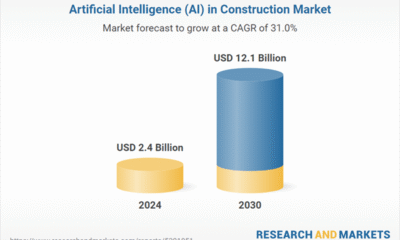Business
OpenAI Is Getting Into the Movie Business With ‘Critterz’

OpenAI, the people who brought you ChatGPT, are teaming up with the writers of Paddington 3 to make a movie about a bunch of forest animals that go on an adventure or something called Critterz.
As reported by The Wall Street Journal, what sets it apart from the rest of the CG animated pack is that Critterz is being made in just nine months on a budget of under $30 million. That’s chump change by industry standards, where animated features usually take years and cost a fortune.
Studios are usually willing to remain patient and cough up the money since animated children’s films are a lucrative business. If Critterz is even a modest success, and people aren’t immediately turned off by the inherent uncanny valley-ness of AI-created imagery, then it could usher in a new era of AI-generated animated film.
The movie, set for a global theatrical release in 2026 after a Cannes Film Festival debut, is being produced by London-based Vertigo Films, Los Angeles-based Native Foreign, and creative director Chad Nelson, a former animator who started the project using OpenAI’s DALL·E tool years ago. He’s now leading a hybrid production model: human-drawn sketches and voice talent are fed into OpenAI’s models like GPT-5 to help stitch the whole thing together. You can watch the original five-minute short film that started it all here.
OpenAI, eager to demonstrate that its collection of ones and zeros can replace every human on Earth, along with all their perspective and experiences gathered over a lifetime, that are then channeled into a single project that means the world to them, is putting its money where its mouth is. Why just talk about what AI could do when you can drop a full-length movie essentially made by no one?
Studios like Disney and Netflix have cautiously dipped their toes into AI for marketing and production support, but no one’s yet fully dived in on a feature like this.
Back in early August, the Wall Street Journal reported that Disney’s behind-the-scenes experiments with AI filmmaking have bordered on disastrous, thanks to a combination of legal concerns over the source of the AI’s inspiration and concerns that its use of AI may scare off the writers, actors, and animators Disney would still need to rely on to some degree in its many other animated and live action projects.
Disney was somehow surprised to discover that implementing a technology that could replace people’s jobs made people not want to work with them. What a shock.
While $30 million for a children’s animated film isn’t all that much, it’s still a gamble for OpenAI. The film has no distribution deal yet, and audiences aren’t exactly sprinting back to theaters for original IP nowadays, let alone one made by AI, which tends to create characters that look like they’re going to break the fourth wall and tell you, specifically, that they’re going to kill you.
But if Critterz somehow manages to get over all that and become a hit, it seems like a bit of an understatement to say that everything will change, but that’s exactly what’s going to happen. A quick and violent shift to an industry with fewer people, and therefore less of their perspective, their artistry. An industry that won’t just be lacking people, it’ll be lacking humanity.
Business
AI cloud surge: Oracle’s Nvidia moment? What to know about Larry Ellison co-founded firm’s sudden rise

On Wednesday, Oracle stunned Wall Street when its shares surged 36% in a single day, the company’s biggest one-day gain since 1992. The rise followed its announcement of a series of multibillion-dollar deals in artificial intelligence (AI) cloud infrastructure, including a landmark agreement with OpenAI. The rally was so dramatic that Oracle co-founder Larry Ellison briefly overtook Elon Musk as the world’s richest person before market corrections set in.The $300 billion OpenAI deal and moreAt the centre of the surge is Oracle’s $300 billion, five-year agreement with OpenAI, one of the largest cloud computing contracts ever signed. The company will provide computing resources and infrastructure to power OpenAI’s advanced models. Oracle has also struck deals with Nvidia, SoftBank, Meta, and xAI, signalling its transformation into a core provider of AI infrastructure.Backlog signals long-term growthCEO Safra Catz revealed that Oracle’s backlog of finalised contracts has reached $455 billion, four times higher than last year, and is expected to cross $500 billion soon. This backlog offers investors confidence in sustained long-term revenue, even as quarterly results sometimes fall short of projections, as reported by ET.Competing with cloud giantsOracle’s position in AI cloud computing now puts it in direct competition with Amazon Web Services and Microsoft Azure. The company expects revenue from its cloud infrastructure business to rise 77% to $18 billion this year, and reach $144 billion within four years, according to news agency AP.The billionaire shuffleThe surge in Oracle’s stock briefly added around $100 billion to Ellison’s wealth, pushing him past Elon Musk in Bloomberg’s billionaire rankings. Musk, whose fortune is closely tied to Tesla, regained the top spot later in the day. But as AP noted, the episode highlighted how AI-driven optimism is reshaping wealth dynamics among tech leaders.Why it matters for AIOracle’s resurgence positions it as a critical enabler of global AI adoption. By providing high-performance, reliable cloud infrastructure, the company is not just fuelling chatbot development but also supporting applications in robotics, pharmaceuticals, finance, and automation. Or as Ellison himself summed it up during an earnings call: “AI changes everything.”
Business
Google’s Gemini Nano Banana AI goes viral, generating 3D Figurines

Nano Banana, the latest image-generating tool of Google’s AI chatbot Gemini, has taken the internet by storm with “gemini nano banana ai 3d figurines” trending on Google.
So, how to use Gemini Nano Banana? Users only have to give simple prompts to Google Gemini to generate realistic figurines of the image uploaded with the prompt. The generated figurine not only looks realistic but can also be put in a setting of the user’s choice.
Steps for using Gemini Nano Banana
First, the user has to open Google Gemini on his or her mobile or computer and log in with their credentials.
Then, the user has to upload an image of their choice that they want to convert into a figurine. However, the image should be clear so the AI can detect it properly. Once the image is uploaded, the user can give a prompt to generate the figurine of his or her choice.
Also Read: OpenAI vs Grok vs Gemini in world’s first AI chess tournament: Guess who won?
How to prompt Gemini Nano Banana
A suitable and easy prompt for the purpose has been shared by Google Gemini on its official X handle. “Create a 1/7 scale commercialised figurine of the characters in the picture, in a realistic style, in a real environment. The figurine is placed on a computer desk,” stated the prompt.
“The figurine has a round transparent acrylic base, with no text on the base. The content on the computer screen is a 3D modelling process of this figurine. Next to the computer screen is a toy packaging box, designed in a style reminiscent of high-quality collectable figures, printed with original artwork. The packaging features two-dimensional flat illustrations,” it added.
Also Read: Eight free AI tools to create Studio Ghibli-style images easily
Other features of Nano Banana
Apart from generating images, Nano Banana can also be used for adding or removing elements in a picture. It can be done with this simple saying: “Using the provided image, please [add/remove/modify] [element] to/from the scene. Ensure the change is [description of how the change should integrate],” reported the Hindustan Times.
Users can also combine multiple images and create a new one. All the user has to do is use this prompt: “Create a new image by combining the elements from the provided images. Take the [element from image 1] and place it with/on the [element from image 2]. The final image should be a [description of the final scene].”
Business
What’s ‘decision-making AI’ and how is it transforming SMEs?

Their findings show many business leaders don’t yet understand how AI can transform the performance of their organisation. The key lies in decision-making AI, or ‘decision intelligence’ – but what does that actually mean?
According to YouGov’s findings published in August 2025, whilst 31% of SME leaders are already using AI-powered tools – and another 15% plan to – just 19% are using AI for decision-making within their business. Strikingly, YouGov’s press release about the new figures took a surprised tone at the concept of using AI to support decision-making, “given the technology’s well-known tendency to occasionally hallucinate answers”.
That sentence highlights a lack of understanding on the part of the author, which perhaps reflects some wider misunderstandings and assumptions. When it comes to business, what do we mean by AI? And are we missing a trick if we’re confined to thinking of it as ChatGPT or Microsoft Copilot and not applying AI at a higher level to help make important business decisions?
Misunderstandings and mixed messages
Confusion often lies in the broad brush with which ‘AI’ is painted. The term can encompass use cases as disparate as recipe suggestions and predictive analytics engines. This blurs the distinction between novelty and necessity, between compute-intensive curiosity and transformational business decision support.
The YouGov data highlights that only 29% of SMEs have any form of in-house AI expertise; others are turning to external suppliers or remaining cautious. That gap in understanding is fertile ground for misconceptions around reliability, risk, and return.
I see the solution as twofold: firstly, with the need for education. Business leaders, particularly within SMEs and the mid-market, need better support from the public and private sector to understand how AI can substantially boost their company’s performance – that AI isn’t some magic wand but a disciplined data-driven support tool.
Secondly, with tailored delivery. AI is most effective when it’s applied within a system that’s bespoke to each firm’s data, culture, and decision-making habits – not when it’s seen as a ready-made tool to be bought off the shelf.
Decision intelligence
While generative AI and agentic AI help streamline desk-based tasks and automate customer service, the true potential of AI is unlocked with ‘decision intelligence’. For most SMEs, this decision-making AI is what will really boost the bottom line.
Decision intelligence involves bringing an organisation’s data together, then using custom machine-learning models that directly answer the questions business leaders ask: “What’s happening in my business?”, “Why is it happening?”, and “What should I do next?”. I describe it as allowing you to look around corners and look into corners.
These AI tools help businesses deliver tangible outcomes in weeks, not years, drawing on data from multiple sources such as Marketing, Sales, Finance, HR, and Operations, to deliver actionable and accountable intelligence.
Take Irish retail chain Petstop as an example. Using Galvia’s AI-powered platform, they created a single, connected view of their data, breaking down internal silos and enabling faster, smarter decisions across every level of the organisation. With intelligent prompts, real-time predictions, and clear insights, their teams began acting with greater confidence and agility, from the head office to the shop floor. As the founder and CEO told me, “it was like turning on the lights.”
Early results have included their best online sales performance outside the holiday period, recovering a 2.5% revenue dip without spending on ads, and launching customer campaigns that prioritised retention over acquisition, delivering far stronger ROI.
A call for intelligent adoption
SMEs are still in the early stages of AI adoption. I often hear leaders say they can see the potential of AI but don’t know which problem to solve first.
My advice: start with one dataset, one decision or one challenge. Often, the most powerful starting point is to unlock value from what you already have. The risk is that, in trying to do everything, you end up doing nothing.
Encouragingly, there are now more structured ways for leaders to build their confidence in AI. Initiatives such as dedicated AI Adoption accelerator programmes give business directors a chance to understand the fundamentals, explore the potential in their own data, and leave with practical next steps for driving impact. The more SMEs can access that kind of support, the faster they’ll move from AI confusion to clarity.
-

 Business2 weeks ago
Business2 weeks agoThe Guardian view on Trump and the Fed: independence is no substitute for accountability | Editorial
-
Tools & Platforms1 month ago
Building Trust in Military AI Starts with Opening the Black Box – War on the Rocks
-

 Ethics & Policy2 months ago
Ethics & Policy2 months agoSDAIA Supports Saudi Arabia’s Leadership in Shaping Global AI Ethics, Policy, and Research – وكالة الأنباء السعودية
-

 Events & Conferences4 months ago
Events & Conferences4 months agoJourney to 1000 models: Scaling Instagram’s recommendation system
-

 Jobs & Careers2 months ago
Jobs & Careers2 months agoMumbai-based Perplexity Alternative Has 60k+ Users Without Funding
-

 Podcasts & Talks2 months ago
Podcasts & Talks2 months agoHappy 4th of July! 🎆 Made with Veo 3 in Gemini
-

 Education2 months ago
Education2 months agoMacron says UK and France have duty to tackle illegal migration ‘with humanity, solidarity and firmness’ – UK politics live | Politics
-

 Education2 months ago
Education2 months agoVEX Robotics launches AI-powered classroom robotics system
-

 Funding & Business2 months ago
Funding & Business2 months agoKayak and Expedia race to build AI travel agents that turn social posts into itineraries
-

 Podcasts & Talks2 months ago
Podcasts & Talks2 months agoOpenAI 🤝 @teamganassi



















